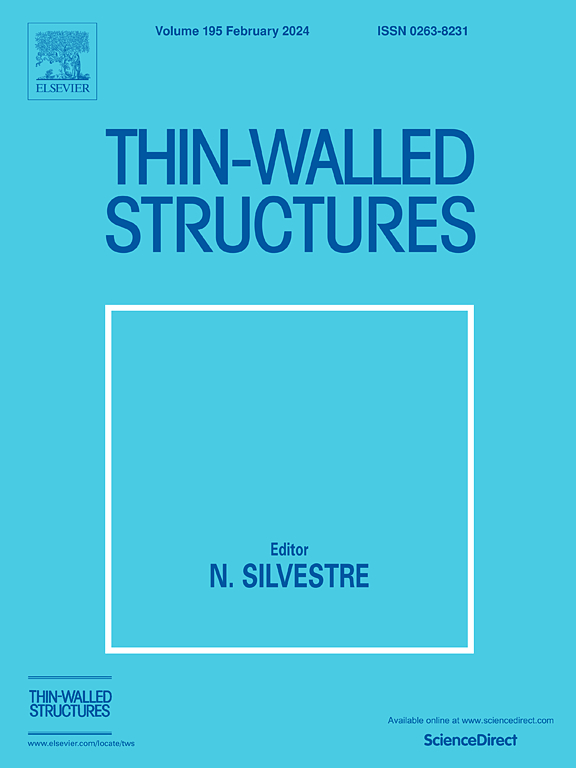连续碳纤维热塑性复合材料的高速冲击响应和冲击后压缩行为实验研究
IF 5.7
1区 工程技术
Q1 ENGINEERING, CIVIL
引用次数: 0
摘要
为满足热塑性复合材料结构在飞机制造等领域应用的迫切需求,本文通过高速冲击(HVI)和冲击后压缩(CAI)实验研究了连续碳纤维增强热塑性复合材料层压板(CCFRTP)的抗冲击性和损伤容限。冲击实验结果表明,层压板在小角度常规冲击下的弹道响应相似,而在大角度斜向冲击下的抗冲击性能显著提高。通过综合分析弹丸的冲击过程、能量吸收水平、层压板的失效形态和内部损伤程度,揭示了层压板在高速冲击下的失效机理。显然,弹丸的撞击角度和速度会显著影响破坏机制的耦合形式,并导致不同的结果。冲击损伤层压板面内压缩实验结果表明,高速冲击损伤会显著削弱层压板的承载能力,层压板的残余强度直接取决于冲击损伤的方式和程度。其中,通过对能量吸收机理的分析,建立了弹道极限值随冲击角变化的趋势预测模型,揭示了高速冲击损伤对层压板残余强度的影响。这项研究有助于更好地理解热塑性复合材料结构对高速冲击载荷的力学响应。本文章由计算机程序翻译,如有差异,请以英文原文为准。
Experimental investigation of high-velocity impact response and compression after impact behavior of continuous carbon fiber thermoplastic composites
In order to meet the urgent needs for the application of thermoplastic composite structures in aircraft manufacturing and other fields, the impact resistance and damage tolerance of continuous carbon fiber reinforced thermoplastic composite laminates (CCFRTP) are investigated by high-velocity impact (HVI) and compression after impact (CAI) experiments in this paper. The impact experiment results show that the ballistic response of laminates under small-angle conventional impact is similar, and the impact resistance of laminates under large-angle oblique impact is significantly improved. The failure mechanism of laminates under high-velocity impact is revealed by analyzing the impact process of the projectile, the energy absorption level, the failure morphology and internal damage degree of laminates comprehensively. It is clear that the impact angle and velocity of the projectile will significantly affect the coupling form of the failure mechanism and lead to differentiated results. The results of in-plane compression experiment of laminates with impact damage show that the bearing capacity of laminates is significantly weakened by high velocity impact damage, and the residual strength of laminates is directly determined by the mode and degree of impact damage. In particular, through the analysis of the energy absorption mechanism, a trend prediction model of ballistic limit value with impact angle is established, and the influence of high-velocity impact damage on the residual strength of laminates is revealed. This study provides a better understanding of the mechanical response of thermoplastic composite structures to high-velocity impact loads.
求助全文
通过发布文献求助,成功后即可免费获取论文全文。
去求助
来源期刊

Thin-Walled Structures
工程技术-工程:土木
CiteScore
9.60
自引率
20.30%
发文量
801
审稿时长
66 days
期刊介绍:
Thin-walled structures comprises an important and growing proportion of engineering construction with areas of application becoming increasingly diverse, ranging from aircraft, bridges, ships and oil rigs to storage vessels, industrial buildings and warehouses.
Many factors, including cost and weight economy, new materials and processes and the growth of powerful methods of analysis have contributed to this growth, and led to the need for a journal which concentrates specifically on structures in which problems arise due to the thinness of the walls. This field includes cold– formed sections, plate and shell structures, reinforced plastics structures and aluminium structures, and is of importance in many branches of engineering.
The primary criterion for consideration of papers in Thin–Walled Structures is that they must be concerned with thin–walled structures or the basic problems inherent in thin–walled structures. Provided this criterion is satisfied no restriction is placed on the type of construction, material or field of application. Papers on theory, experiment, design, etc., are published and it is expected that many papers will contain aspects of all three.
 求助内容:
求助内容: 应助结果提醒方式:
应助结果提醒方式:


